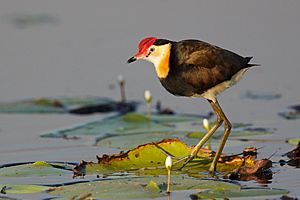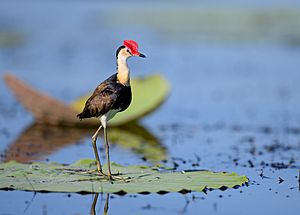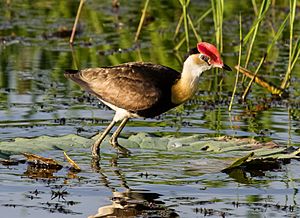Comb-crested jacana facts for kids
Quick facts for kids Comb-crested jacana |
|
|---|---|
 |
|
| Conservation status | |
| Scientific classification | |
| Genus: |
Irediparra
|
| Species: |
gallinacea
|
The comb-crested jacana (Irediparra gallinacea) is a unique bird found in tropical wetlands. It's also known as the lotusbird or lilytrotter because it walks on floating plants like water lilies. This bird is the only one of its kind in the Irediparra group of jacanas.
Contents
What Does It Look Like?
This bird is easy to spot! It has a black head and neck. A soft, red comb sits on its forehead. This comb is pinker when the bird is ready to breed, and more orange at other times. Its face and throat are white, which stands out against the black.
The jacana has a wide black band across its chest and a white belly. When it flies, you can see its black underwings and flight feathers. Its back and upper wings are mostly grey-brown. The bird has very long legs and super long toes that trail behind it in flight. These long toes help it walk on floating plants.
Male jacanas are a bit smaller than females. Males are about 20–22 cm (7.9–8.7 in) long and weigh 68–84 g (2.4–3.0 oz). Females are longer, measuring 24–27 cm (9.4–10.6 in) and weighing 120–150 g (4.2–5.3 oz). Their wings can spread from 39 to 46 cm (15 to 18 in) wide.
Where Does It Live?
You can find the comb-crested jacana in many places. These include south-eastern Borneo, the southern Philippines, Sulawesi, the Maluku Islands, and the Lesser Sunda Islands. They also live in northern and eastern New Guinea, New Britain, and northern and eastern Australia.
These birds love large freshwater wetlands, swamps, and lakes. Their favorite spots have lots of floating plants. Think of water-lilies or water hyacinth that form a thick mat on the water. The jacana can walk right on top of these plants! Even though it's not found everywhere, this bird is not currently in danger globally.
How Does It Behave?
Walking and Flying
The comb-crested jacana walks slowly and carefully. It often gathers in groups with other jacanas. If something scares it, the bird flies low over the water. Then, it lands again on the floating plants.
Raising Young
The comb-crested jacana has an interesting way of raising its young. The female bird lays her eggs in nests built by different males. She lays four shiny, pale brown eggs with black marks. Only the male jacanas sit on the eggs to keep them warm until they hatch. When the young birds hatch, they are already quite developed. They can leave the nest very soon after being born.
What Does It Eat?
This bird eats seeds and water insects. It picks them right off the floating plants on the water's surface.
What Does It Sound Like?
The comb-crested jacana makes a squeaky, high-pitched chittering sound. Some people describe its call as a shrill trill or a soft, explosive bugle.
See also
 In Spanish: Jacana crestada para niños
In Spanish: Jacana crestada para niños




